Faces of Hyde Park with Brian Carroll
I must have stumbled upon Brian’s work when I first moved to Chicago — roughly five years ago — where I found my home in Hyde Park. It’s been years and…
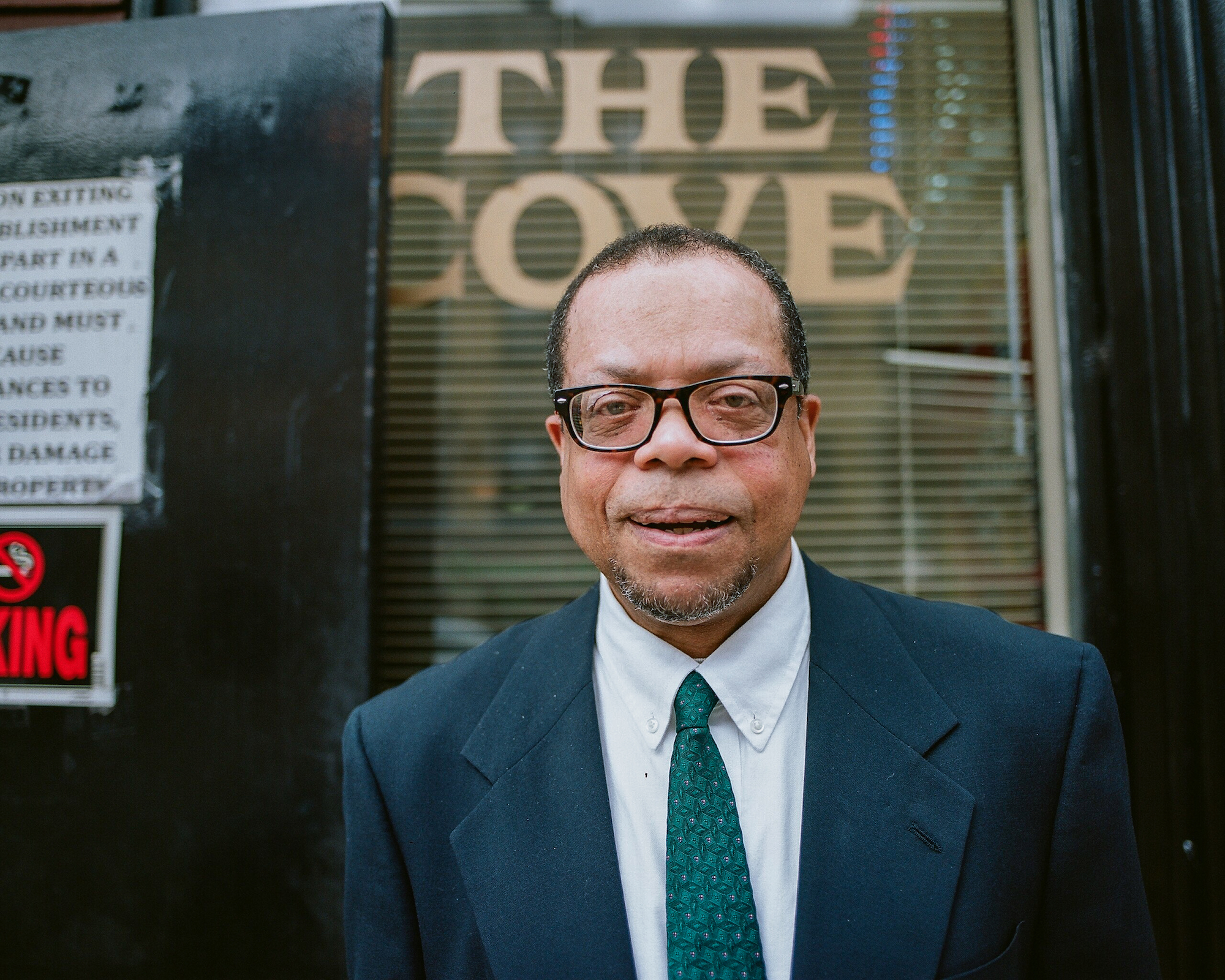
I must have stumbled upon Brian’s work when I first moved to Chicago — roughly five years ago — where I found my home in Hyde Park. It’s been years and I’m still here, still walking down 55th, taking a left, passing The Cove and finding a sunny spot at Promontory Point. After five years I have come to know familiar faces, people who I’ve never spoken to but I’ve seen every morning.
When I stopped into Open Produce, the local grocery store, this summer, a regular customer stopped me and said, “I didn’t see you at the lake this morning. I brought Bridget, but we must have missed you.” Bridget, his dog, is always swimming over to me during my morning dips. We usually talk for a few moments when I exit the water, but it’s nothing monumental. But there he is, every morning, and there I am, too, like clockwork waiting to see each other on our morning swim.
Since following him on social media years ago, I’ll scroll through my feed and I’ll stop, and smile, as I see another portrait of a character or figure that I’ve seen on 53rd or in Hyde Park Records or standing on the corner of 55th and S. Hyde Park Boulevard. Brian’s got ’em all. His collection of photographs is a catalog of people I see who I don’t know very well, but who I have come to love.
I decided I wanted to reach out to Brian and see his transition from moving to Hyde Park to his new (but old) home in Denver, Colorado.
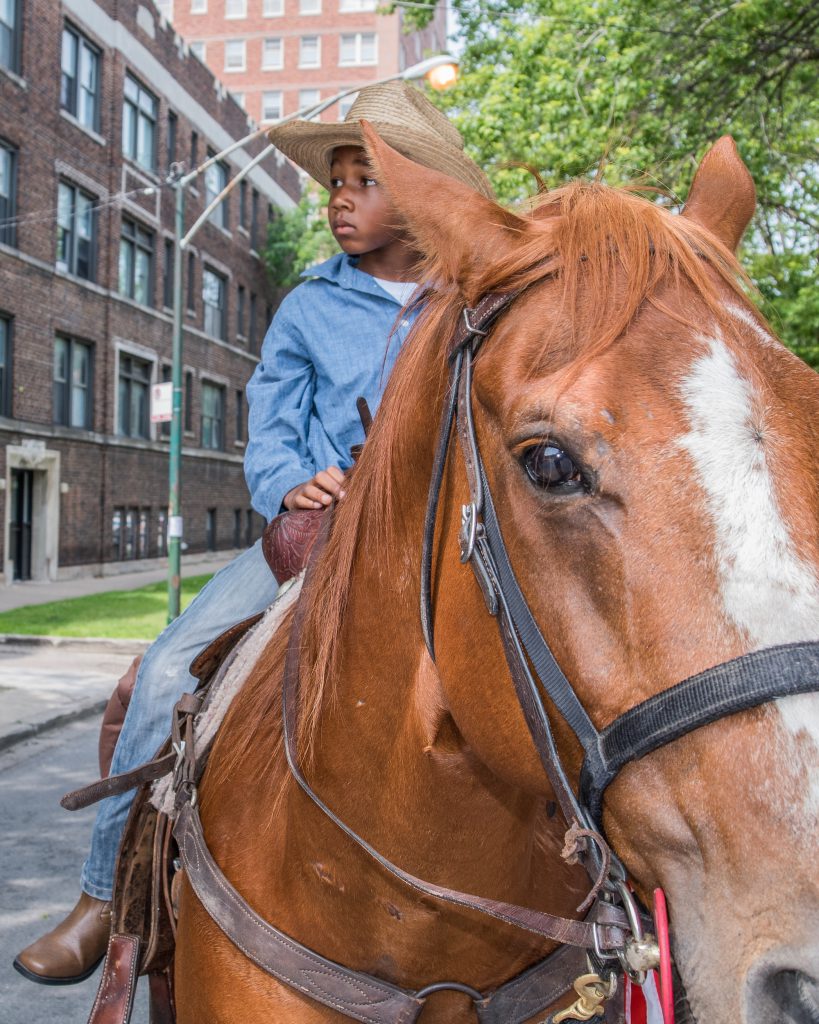
Image: A photo of a young boy wearing blue jeans a blue long sleeve shirt is riding a horse down the street in Hyde Park. The horse is on the right side of the composition with only one eye being visible. The photographer and viewer are at the same height as the horse, looking up at the boy. The boy is wearing a hat and looking off into the distance to the left side of the frame. Photo by Brian Carroll.
S. Nicole Lane: When did you begin shooting portraits of people?
Brian Carroll: First off, thank you so much for this opportunity to speak about my work and myself. Well, I studied creative writing in college and, when I realized I was not very good at maintaining the intensive, disciplined act of writing stories, I refocused my attention to the study of literature; I suppose I thought that maybe I wasn’t great at writing stories because I didn’t really know how stories were made, how they should look? This contour of inquiry eventually culminated in a doctoral dissertation, which examined how portrait photography was used in postmodern American literature (abstract of an abstract: portrait photography was the chief conduit for building connections in a time when ethical association was seemingly bereft of an appropriate vehicle). So, while this is entirely banal, I do feel that storytelling is a key element of what makes us human. I’ve always owned a camera since high school (the mid-90s), but I really only focused on portraits the deeper I got into this academic line of discourse. This was the way I could make stories, and to tell those of others.
SNL: How do you approach someone in the street to take their photograph? Are you denied often? I studied photography but always had uncomfortable moments when I would want to shoot a portrait of someone, but was too afraid to ask. Can you explain this process?
BC: It is definitely not easy to make that initial appeal, but I’ve found that the vast majority of people truly want to have their picture taken. It’s a form of attention paid to them they might not normally experience, or were definitely not expecting in that moment. For the most part, people appreciate that kind of spontaneity in their day. And with this said, I can’t really recall being turned down. It’s happened for sure, but it is not memorable, which I think also reinforces how it’s not really a big deal to ask because what I remember most are the associative conversations, and the resulting images (these images really are secondary, no?), beginning from that first request. It’s not the people that were dubious and politely declined that I recollect whatsoever. Maybe it’s an interesting item of clothing that draws me in, or how their hair is fashioned, or the distinct color of their eyes. But it is necessary — mandatory — to explain one’s self, to be transparent at what the motivation is for the portrait collaboration; expressing this not only acknowledges their uniqueness, or justifies their specific stylistic choices, but allows for a moment of shared and equal communication. Of course, this only works if you are being genuine about it all — which if you’ve already made it this far in the creative process, means that you are.
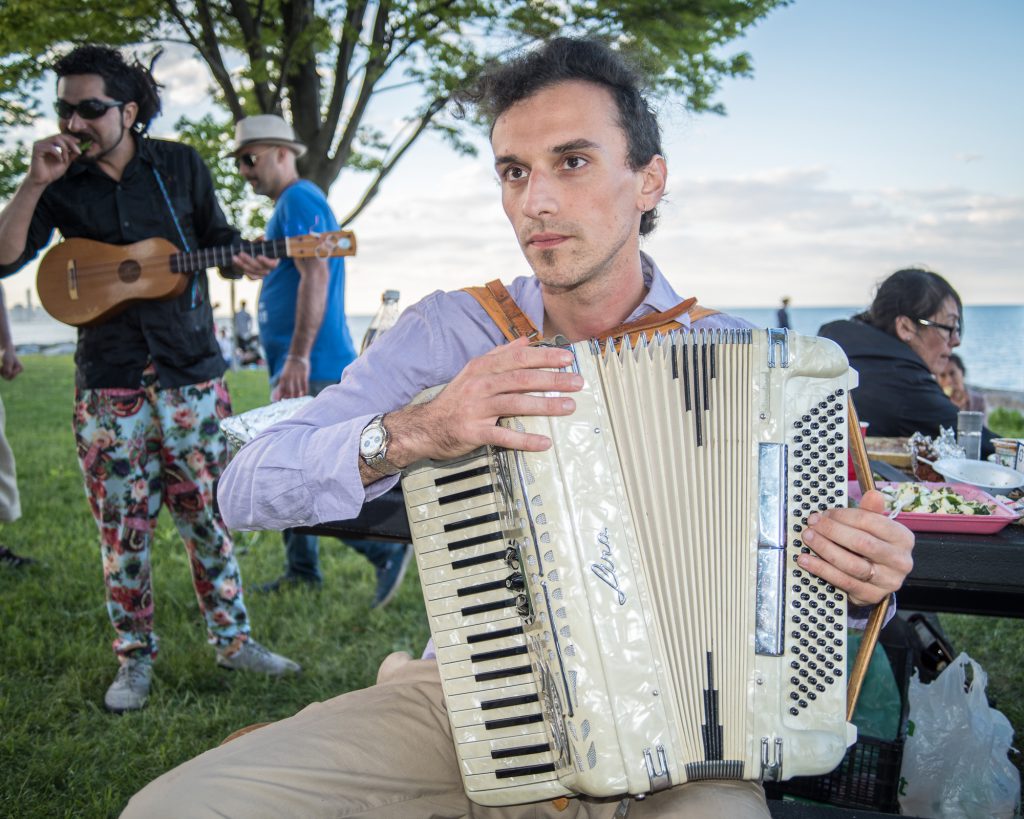
Image: In the forefront of the image is a person holding an accordion while seated. He is staring off into the distance. There is food behind him and a table. In the far-off distance is the lake. Two people are in the background to the left of the seated person. One is holding a stringed instrument and wearing floral pants and sunglasses. Another figure is walking through the background of the shot and wearing a blue shirt and a hat. Photo by Brian Carroll.
Indeed, it is certainly easy to get wrapped up in your own head before “The Ask.” Issues of race, class, and gender (just to be all-encompassing here) can trip you up if you let them; and that’s not to say that they shouldn’t be in both the background and foreground of your mind. But the point is, there is always something — and, truly, many things — that we have in common with our subjects, and the goal is to show those, speak to them, and demonstrate them. We are all so different but so similar, all so proximal to one another, yet othered, and recognizing this liminality is crucial. It is difficult to express here. Often someone’s first question is “What’s the picture for?” Logistically speaking, having a “portfolio” album on your phone really helps — you can immediately pull it up and show people right there on the street what it is you’re going for. Having those thumbnails at hand builds a sort of instant ethos (you don’t need to explain you are a photographer, they see it), especially if you even let the person scroll themselves: hand them your phone, let them search with their forefinger. And I almost always shake hands with the person when we’re done, or briefly clasp their shoulder, or some similar physical gesture. Concluding with that basic human touch — I believe anyways — solidifies and finalizes the experience. Of course, there never really is finality, is there?
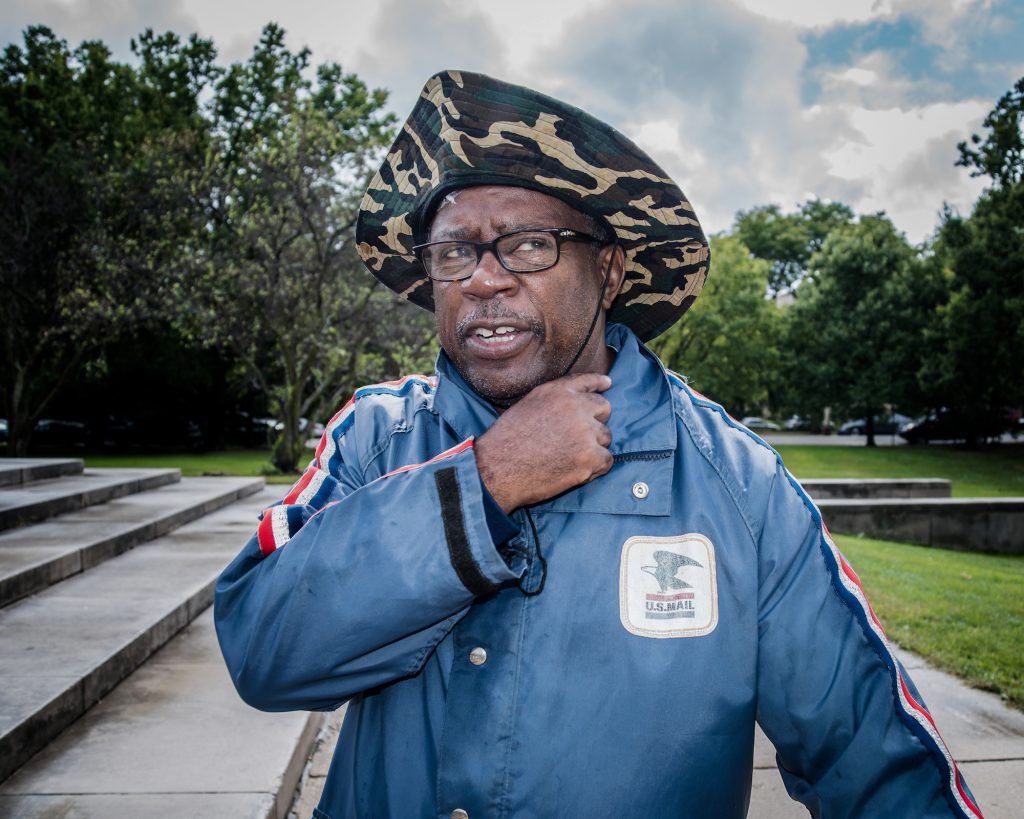
Image: A man wearing a US Mail Service uniform is wearing glasses and wearing a camo hat. He has his right arm reaching up towards his collar. His mouth is open as if in mid speech and he is looking to his left. The background has steps and green grass with trees. Photo by Brian Carroll.
SNL: Let’s talk about your time in Hyde Park. Can you discuss some of your favorite people that you met or that you’ve shot? I’ve always enjoyed looking at your images from my neighborhood because many of the subjects are people, or characters, that I know from walking down the street.
BC: Thank you. Yes, that was certainly one of the best things about living in Hyde Park: seeing the same people all the time. A true neighborhood! The security guard at the Treasure Island (RIP Treasure Island) parking lot, the hearing-impaired woman asking for change for milk, the all-season lake swimming club down at the Point, the motorized wheelchair guy with the three Chihuahuas. We lived across the street from this interesting building — definitely an older crowd and a lot of the residents that clearly had health issues (a fire truck or ambulance was there, no joke, about every other day). They hung outside a lot, folks in motorized wheelchairs, with canes, and the like. The informal caretaker of this place was a man named Al (he’s the one with the Bernie Mac shirt); he would be out there sweeping off the sidewalk every morning, saving parking spots for people, looking out for neighbor’s package deliveries. He loved seeing my young daughter and even though we might not cross the street to chat with him every day, we would at least wave at each other from across Harper and he would bellow a greeting, usually to my daughter, who he called “little piggy.”
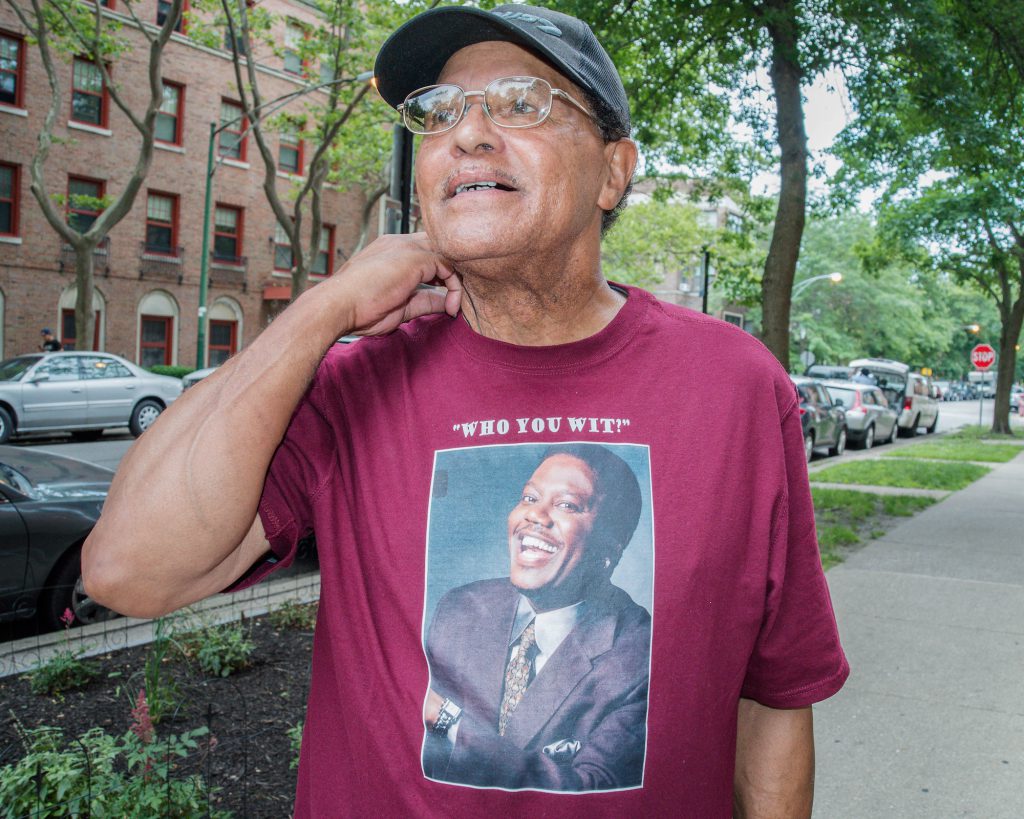
Image: A man, Al, is standing on a sidewalk wearing a red shirt that says, “Who You Wit!” with a photo of Bernie Mac on it. He has glasses and a baseball cap on. His right arm is bent up towards his neck. He is looking straight ahead away from the camera. Photo by Brian Carroll.
Also in this building was a man named Kenneth whom I shot portraits and video of on at least three or four occasions. He was one of the people in a motorized wheelchair, and he had three Chihuahuas of varying sizes (and varying temperaments) that would follow him as he zoomed around the block. I learned he used to work for Motown Records back in the 60s and 70s, and he wanted me to shoot his birthday party, which was going to be Motown themed. But unfortunately, that never came to fruition. I do think about that a lot, what sort of amazing people I would have met there. The stories and the faces! I mentioned the Point earlier — that was always a good spot to run into some characters.
One time, I think it was on Labor Day, there was this Italian guy playing accordion and singing in this deep, old-world voice. I’d been riding my bike around the loop and could hear him from quite a ways back. Once I rolled up to his group, I stopped and listened for some time, getting pretty emotional just hearing this almost ancient language, that of course I didn’t understand, effortlessly weave around the lilt of his melodic accordion. I didn’t stop to take his portrait until he was finished playing, and even then, almost forgot to do so.
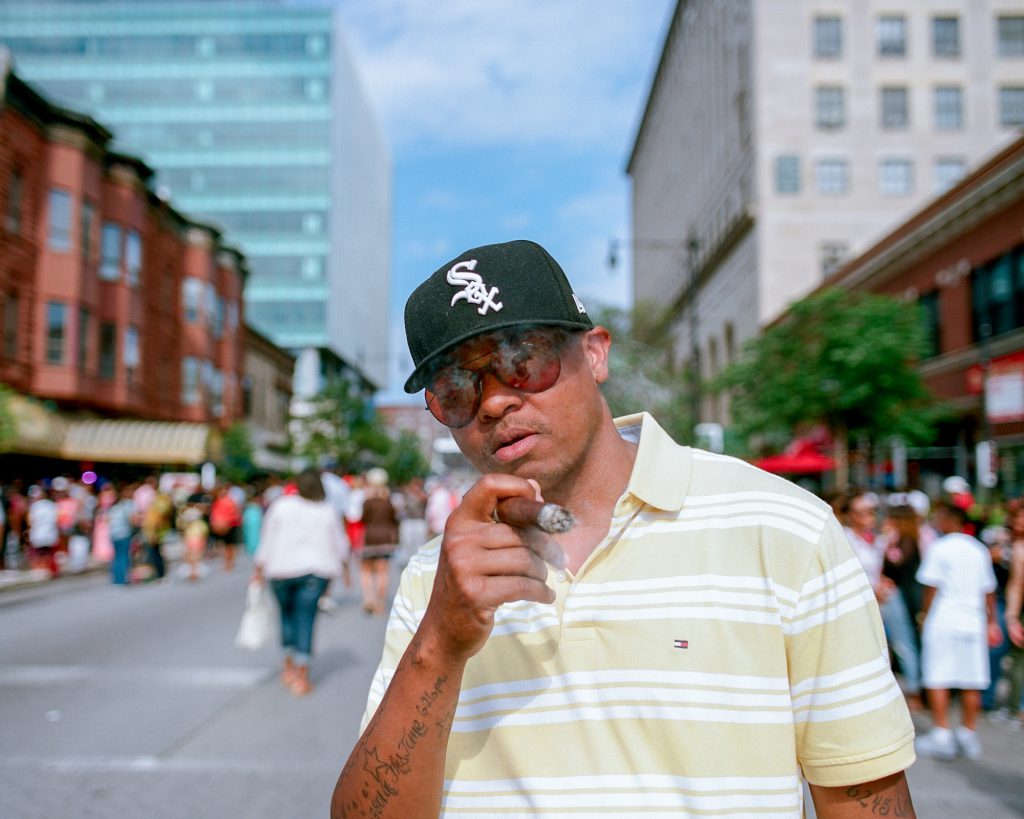
Image: On 53rd street people are walking in the background. A figure stands in the center smoking a cigar and wearing a White Sox hat.He also has a yellow stripped short sleeve shirt on and sunglasses. He is looking directly into the camera. Photo by Brian Carroll.
SNL: How long did you live in Chicago and what brought you to Hyde Park?
BC: I lived in Chicago for just over three years, all in Hyde Park. My wife was there to complete her residency in family medicine and I ended up working at the University of Chicago Press during that time.
SNL: You live in Colorado now. How is your visual practice different since moving there? What do you miss about Chicago, and what are some of the benefits of being an artist in Denver?
BC: I grew up here, went to elementary school, middle school, and high school here, and I moved away after I graduated with my undergraduate degree in 2004. Now I’m back after 15 years away — my parents still live here as does my sister and her family, they all stayed. But there are very few parts of Denver, if any, that are as walkable as Hyde Park, or Chicago as a whole.
Video: A man sits in a motorized wheelchair with three Chihuahuas. A younger adult and a child play with and pet the dogs. Video by Brian Carroll.
You could go weeks in Hyde Park without ever moving your car (street sweeping ticket avoidance aside), everything you needed was there: groceries, work, my daughter’s school. It was all in the neighborhood. My wife was the only one that had to commute with her car. But Denver just doesn’t have that, it’s very car-centric and this is something I didn’t quite realize being away for so long, especially in a place like Hyde Park. So, with less walking, of course, this naturally means less chance to meet and interact with people on the street, to talk with them, hear their stories, take their portraits. Thusly, I feel like I’m in a bit of an artistic slump these days.
Even more jarring is the fact that I still work for the University of Chicago Press, albeit in a remote capacity, so I’m strangely still tethered to Hyde Park, which is an odd sensation, it’s like this reminder of what once was? How does one translate the same “success” after being geographically displaced? Don’t get me wrong, we wanted to move back here, I love Denver dearly, but I suppose I didn’t realize how difficult it would be to duplicate that creative boon. Any maybe I should not attempt to do so. I just need to adapt and evolve and that is an exciting prospect I need to embrace more fully.
Featured Image: A man in a blue suit and green tie is standing directly outside of The Cove, a bar on 55th St. He has eyeglasses on and is looking into the camera. Photo by Brian Carroll.
 S. Nicole Lane is a visual artist and writer based in the South Side. Her work can be found on Playboy, Broadly, Rewire, i-D and other corners of the internet, where she discusses sexual health, wellness, and the arts. She is also the Office Manager for the Chicago Reader. Follow her on Twitter.
S. Nicole Lane is a visual artist and writer based in the South Side. Her work can be found on Playboy, Broadly, Rewire, i-D and other corners of the internet, where she discusses sexual health, wellness, and the arts. She is also the Office Manager for the Chicago Reader. Follow her on Twitter.
Photo by Jordan Levitt.